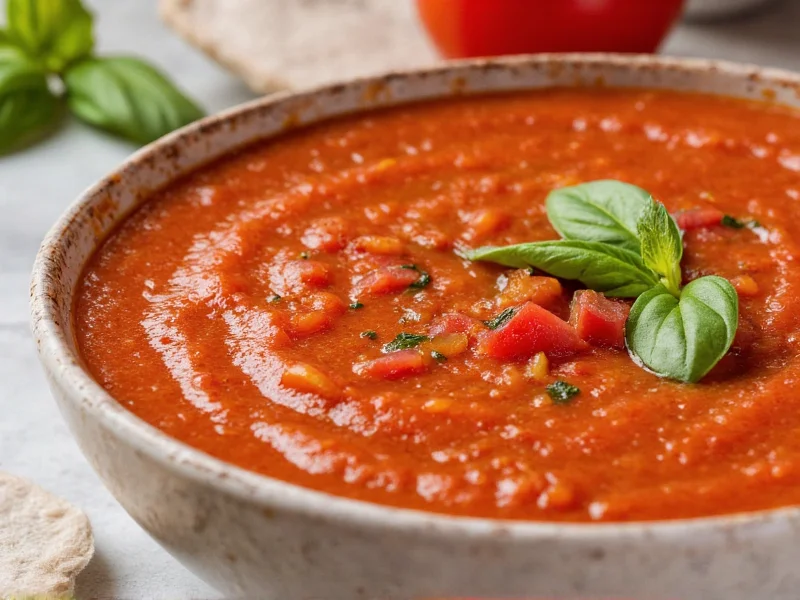The Superior Flavor of Fresh Tomato Basil Soup
While canned tomatoes offer convenience, fresh tomato basil soup delivers a vibrant, garden-to-table experience that canned versions simply can't replicate. The difference lies in the nuanced sweetness and bright acidity of vine-ripened tomatoes at their seasonal peak. When you make tomato basil soup with fresh tomatoes, you're capturing summer's essence in a bowl—something especially valuable during August and September when tomatoes overflow at farmers' markets.
Professional chefs consistently prefer fresh tomatoes for seasonal soups because they contain higher levels of volatile compounds that create complex aromas. These delicate flavor compounds diminish during the canning process, resulting in a flatter taste profile. By using fresh produce, you gain control over seasoning and texture—critical elements often compromised in canned alternatives.
Selecting the Perfect Tomatoes
Not all tomatoes work equally well for fresh tomato soup without canned tomatoes. Your selection dramatically impacts the final result:
| Tomato Variety | Best For | Flavor Profile |
|---|---|---|
| Roma/Plum | Classic texture, less watery | Rich, concentrated, lower moisture |
| San Marzano | Authentic Italian flavor | Sweet with low acidity, meaty flesh |
| Heirloom | Complex flavor variations | Varies by variety, often floral notes |
| Garden Surprise | Using mixed backyard harvest | Blend of sweet and tart notes |
Choose tomatoes that feel heavy for their size with taut, unblemished skin. Avoid refrigeration, which destroys flavor compounds—store at room temperature until ready to use. For the best tomato varieties for fresh tomato soup, prioritize varieties with deep red color and minimal green shoulders, indicating full ripeness.
Essential Ingredients and Why They Matter
The magic of homemade tomato basil soup with garden tomatoes comes from balancing just a few quality ingredients:
- Fresh tomatoes (3-4 lbs) - The foundation. Roma tomatoes provide ideal texture with less water content.
- Fresh basil (1 cup packed) - Adds aromatic complexity; dried basil won't deliver the same bright flavor.
- Yellow onion (1 medium) - Sweeter than white onions, creating a better flavor base.
- Garlic (3-4 cloves) - Use fresh, not pre-minced, for superior flavor development.
- Extra virgin olive oil - Choose a fruity variety that complements tomatoes.
- Vegetable or chicken stock (2 cups) - Use low-sodium to control seasoning.
- Heavy cream (optional, 1/2 cup) - Adds richness; substitute coconut milk for dairy-free.
Avoid adding sugar—ripe tomatoes contain sufficient natural sweetness. If your tomatoes lack sweetness, they likely weren't fully vine-ripened.
Step-by-Step Fresh Tomato Basil Soup Recipe
This easy fresh tomato soup without canned tomatoes requires proper technique to maximize flavor:
- Prepare tomatoes: Score an "X" on the bottom of each tomato. Blanch in boiling water for 30 seconds, then transfer to ice water. Peel skins and remove cores. Cut tomatoes in half and gently squeeze to remove excess seeds.
- Sauté aromatics: Heat 2 tbsp olive oil over medium heat. Add chopped onion and cook until translucent (5-7 minutes). Add minced garlic and cook 1 minute until fragrant—don't let it brown.
- Cook tomatoes: Add prepared tomatoes, 1 tsp salt, and 1/4 tsp black pepper. Cook uncovered for 20-25 minutes, stirring occasionally, until tomatoes break down and liquid reduces by half.
- Add herbs and liquid: Stir in 1/2 cup chopped basil and stock. Simmer 10 minutes to meld flavors.
- Blend until smooth: Use an immersion blender directly in the pot (or carefully transfer to countertop blender in batches). Blend until completely smooth.
- Final seasoning: Return to low heat. Add remaining basil, cream (if using), and adjust salt to taste. Simmer 5 minutes—don't boil after adding cream.
Avoiding Common Fresh Tomato Soup Mistakes
Even experienced cooks make these errors when preparing fresh tomato soup cooking time sensitive recipes:
- Skipping the seed removal: Tomato seeds contain excess moisture and bitterness. Taking 5 minutes to remove them dramatically improves flavor.
- Overcooking the basil: Add half the basil during cooking and the rest at the end. Prolonged cooking turns basil bitter.
- Using unripe tomatoes: Underripe tomatoes lack sufficient sugar to balance acidity, resulting in sour soup.
- Blending while too hot: If using a countertop blender, let soup cool slightly and fill only halfway to prevent dangerous steam explosions.
Serving and Storage Tips
For the best experience with your summer tomato basil soup from garden harvest:
- Serving temperature: Serve hot but not boiling—165°F (74°C) preserves delicate flavors better than scalding temperatures.
- Perfect pairings: Crusty bread, grilled cheese sandwiches, or a simple arugula salad complement the soup's acidity.
- Storage: Keep in airtight container in refrigerator for up to 4 days. The flavor often improves on day two as ingredients meld.
- Freezing: Freeze without cream for up to 3 months. Thaw in refrigerator overnight and reheat gently, adding cream after thawing.
Seasonal Adaptations
When tomatoes aren't in season, adapt your how to make tomato soup with fresh tomatoes approach:
- Winter version: Use high-quality canned San Marzano tomatoes with a splash of tomato paste for depth. Add roasted red peppers for complexity.
- Preservation tip: Blanch and freeze fresh summer tomatoes for year-round use. They'll have softer texture but excellent flavor for soups.
- Flavor boost: In off-season, add a pinch of red pepper flakes and 1 tsp balsamic vinegar to mimic summer ripeness.











 浙公网安备
33010002000092号
浙公网安备
33010002000092号 浙B2-20120091-4
浙B2-20120091-4